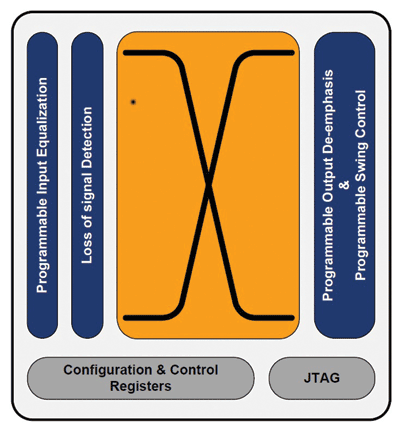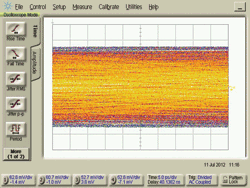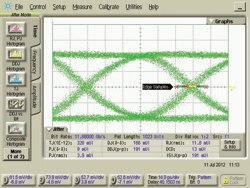Key requirements for ultra high-definition television
Switching and signal conditioning is becoming important as video traffic drives escalating bandwidth requirements
By RYAN LATCHMAN
V.P Strategic Marketing & Applications Engineering
FERNANDO GONZÁLEZ
Product Applications Engineer, and
JINU CHOI
Senior Product Manager
Mindspeed Technologies
www.mindspeed.com
The need for switching and signal conditioning is becoming increasingly important for next-generation networking equipment, especially as video continues to drive network bandwidth requirements ever higher. The content distributed throughout the broadcast studio will be moving beyond 3G-SDI to 4K and 8K formats such as Super Hi-Vision and Ultra-HD that operate at unprecedented higher data rates, creating the need for ever higher speed routers and crosspoint switches that feature integrated signal conditioning to ensure error-free sustained data transmission.
In May 2012, the ITU announced recommendations for a new set of Ultra High Definition Television (UHDTV) standards that will continue to drive demand for signal-conditioning solutions. Now in the process of being submitted for review, the recommendations were developed by Study Group 6 of the body’s radio communications division (ITU-R), with input from television industry experts as well as broadcasters. Following the ITU announcement, the industry is now laying out a two-step process for migrating from today’s standard-definition specifications to new formats that ITU Chairman David Wood said in a statement will deliver a “breath-taking experience.” UHDTV is expected to bring unprecedented levels of realism and viewer enjoyment, and the ITU recommendations signal that developers and other organizations can now begin working to make UHDTV a reality.
In order to fulfill this vision, crosspoint switches must deliver a combination of adequate switching capacity and optimized signal integrity to enable a new generation of higher-speed routers, switchers and multi-viewers that can be used to create this content and support it serially in demanding real-time broadcast networking applications. The next generation of crosspoint switches also must deliver low power consumption and backward-compatibility with lower-speed SDI interfaces, providing a seamless migration path to the higher speeds of emerging UHDTV formats.
New UHDTV standards
The new ITU-R Recommendations for UHDTV have been submitted by the ITU-R Study Group 6 for approval. These Recommendations chart a two-step course for higher-quality UHDTV standards, each step similar to the one taken from standard-definition television to today’s 1920 by 1080p Full-HD format as defined by the ITU-R Rec. 709 standard.
According to the ITU’s announcement, the first level of UHDTV picture quality, also called “4K,” is defined at a horizontal and vertical pixel count of 3,840 x 2,160 (equivalent to about 8 megapixels), and the next level, called “8K,” is defined at 7,680 x 4,320 (equivalent to about 32 Mpixels). This contrasts with today’s HDTV pictures, whose horizontal and vertical pixel count is equivalent to between 1 and 2 megapixels. In other words, 4K will have twice the horizontal resolution and four times the spatial resolution of Full-HD in a progress format. The larger 8K resolution doubles 4K, and is 16 times the resolution of Full-HD. One of the first HDTV production trials at these higher-resolution specifications will be launched by the BBC in conjunction with the London 2012 Olympics, using the Super High Vision (7680 x 4320) video format developed by NHK Science & Technology Research Laboratories.
The latest evolutionary HDTV standards, including 1080p/50 (1920×1080), are already pushing switcher requirements to their limits. For example, the 1080p/50 signal requires a 3-Gbit/s baseband bit rate, which is double that of the earlier 1080i/25 or 720p/50 formats. Next-generation systems will need to support serial uncompressed UHDTV SDI, including both Mapped Society of Motion Picture and Television Engineers (SMPTE) ST2036-3-2010 at 10.692Gb/s as well as SDI at 11.88Gb/s. They also must support increased-density HD/3G systems, and multiplexed SDI streams, including up to four 3G SDI streams or 8 HD SDI streams.
Solving the problem
Crosspoint switches are a critical piece of the puzzle. Next-generation digital video switching systems already must meet rigorous performance and timing requirements through the entire signal path in order to sustain robust transmission. The challenge becomes even greater with the move to 4K and 8K formats, such as Super Hi-Vision and Ultra-HD that operate at much higher data rates, which makes switching systems significantly more susceptible to jitter and timing problems during signal transmission across backplanes and cables.
By delivering signal equalization at both inputs and outputs, today’s crosspoint switches compensate for difficult channels by mitigating or eliminating signal degradation due to transmission line effects (see Fig. 1). This dramatically improves signal integrity, enabling error-free data transmission at high data rates. Today’s mainstream crosspoint solutions combine multi-rate broadcast video routing and switching in a single device and ensure signal integrity at a system level for rates up to 11.5Gb/s per lane. This results in aggregate switching capacity of up to 1.2Tb/s and above, which can be offered at very low per-port power consumption.

Fig. 1: Today’s crosspoint switches deliver signal equalization at both inputs and outputs, along with features that facilitate link optimization and system-level performance monitoring.
The latest crosspoint switches provide even higher bandwidth, with each switching path operating independently at any data rate of up to 12.8Gb/s. Given that the size of the switching core dictates the size of the router, crosspoint switches will need to incorporate a non-blocking 160×160 matrix size in order to yield the necessary 2Tb/s of switching capacity that is required for users to route significantly higher numbers of serial data streams. Mindspeed’s M21605 crosspoint switch that delivers this large routing switcher size also simplifies the design of very large matrix video broadcast routing switchers. Mindspeed’s crosspoint switches also enable loopbacks on any channel to aid system tests, debugging and optimization.

Fig. 2a: Unequalized signal at 11.88 Gbits/s after 24-dB insertion loss backplane at Nyquist frequency (6.4 GHz).

Fig. 2b: Equalized signal using Mindspeed’s M21605 160 x 160 crosspoint switch at 11.88 Gbits/s after 24-dB insertion loss backplane at Nyquist frequency (6.4 GHz).
To deliver the necessary signal integrity for higher data rates, each crosspoint input in an UHDTV switcher will need to be equipped with an adaptive equalizer capable of compensating for up to 25 decibels (dB) of loss at 12.8 Gb/s. This will ensure adequate throughput while simplifying design and reducing system development costs since there is no need to spend time optimizing each channel. UHDTV crosspoints also much feature ultra-low jitter, and programmable transmit drivers that include three-tap programmable output pre-emphasis and adjustable swing for link optimization. Additionally, integrated diagnostic features such as programmable loss of signal (LOS) and temperature sensor capabilities are important for facilitating system-level performance monitoring.
Finally, higher-bandwidth links require lower power consumption per bit communicated. As a result, crosspoints for UHDTV systems will require exceptionally low per-port power consumption so that they can be used to build systems that are more energy-efficient, generate less heat and operate more reliably. Switches must consume the least power possible with all channels active, and operate at as low standby power as possible.
In addition to crosspoint switches, there are a number of other products that can be used to ensure superior signal quality and reliability for digital video signal transmission at higher speeds. These include serial digital interface (SDI) equalizers, SDI reclockers, SDI cable drivers and optical transport solutions that pave the way beyond 3G-SDI data rates to 4K and 8K formats. For instance, advances in cable equalizers are delivering the lowest possible output jitter for demanding digital broadcast video applications across extended cable lengths. Similarly, SDI quad reclockers are available that integrate a small crosspoint switch at the input and provide integrated trace equalization and automatic rate detect (ARD) circuitry. These and other advances will continue to build a foundation for optimizing signal integrity at UDHTV data rates.
The recent ITU recommendations for UHDTV lay the foundation for a new era in television that will bring an unsurpassed immersive experience to viewers. Realizing the promise of UHDTV will require video crosspoint switches capable of optimizing data rate, bandwidth, performance and power efficiency of serial routing and production switches. Crosspoint switches with built-in signal conditioning technology will be essential in order to deliver sustained transmission performance at these higher data rates, as will non-blocking matrix sizes that are large enough to yield the necessary switching capacity. ■
Advertisement
Learn more about Mindspeed Technologies





